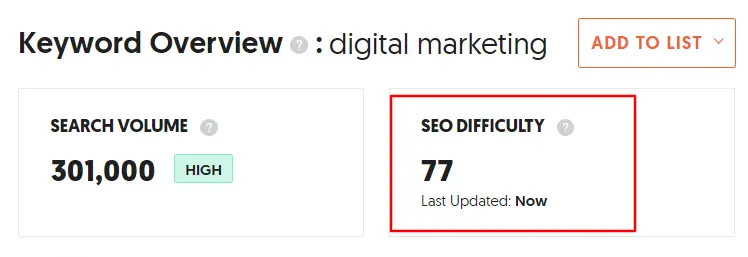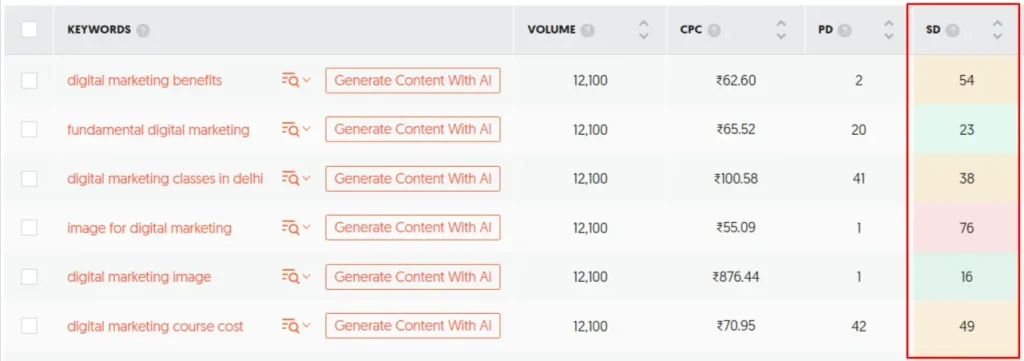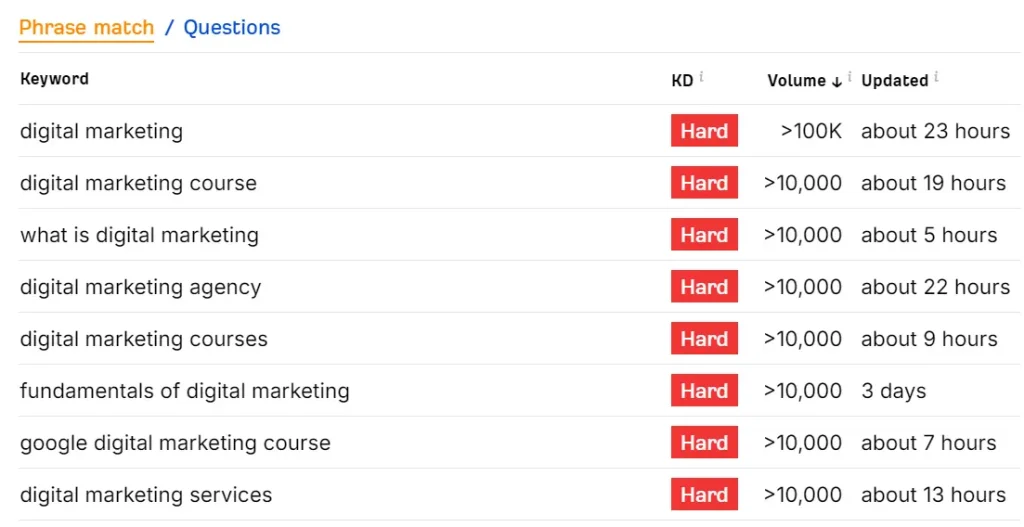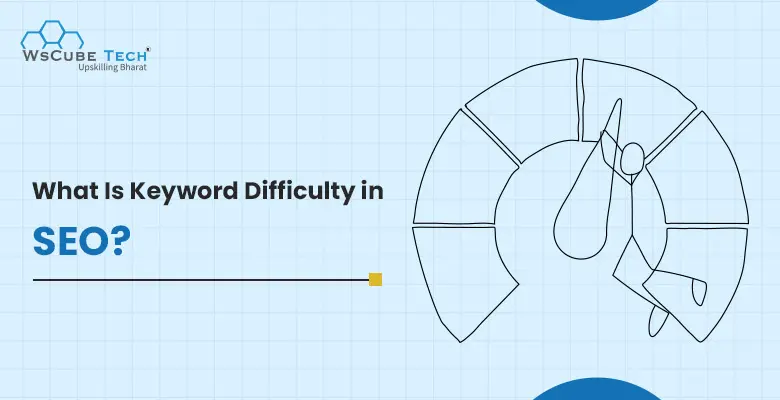Are you feeling the challenge of ranking on Google’s organic search results for a particular keyword? Don’t worry; we have got you covered!
Keyword difficulty (KD) may not be the most buzzworthy topic in SEO (search engine optimization), but it’s a powerful metric with immense potential. By grasping KD, you can make informed decisions about your target audience’s ranking for specific terms, empowering you to make strategic choices that form the backbone of your SEO strategy.
In this blog, we will delve into the world of keyword difficulty, exploring how it’s calculated, why it’s a crucial aspect of keyword research for SEO and much more. Get ready to unlock valuable insights!
What is Keyword Difficulty in SEO?
Keyword difficulty measures how hard a web page can rank on a search engine result page (SERP) for a given phrase or keyword. A cornerstone of SEO, this concept helps you assess the feasibility of ranking for relevant keywords, reassuring you of its significance in your SEO strategy. Learn to create a comprehensive SEO strategy by enrolling in an online SEO course.
The keyword difficulty score, a logarithmic metric ranging from 1 to 100, is a versatile tool in SEO. A higher score indicates a more challenging keyword to rank for, while a lower score suggests an easier one. However, it’s crucial to note that the value of KD can differ among SEO keyword research tools. SEMrush, Ahrefs, and Google Keyword Planner, for example, each offer their own version of a keyword difficulty checker, providing distinct perspectives on your keyword strategy.

What does the Keyword Difficulty Score Convey?
The value of KD tells you how tricky it’s likely to be to rank for a certain keyword, corresponding to the strength of the competition. However, there’s no standard for calculating the difficulty or competition to rank for a specific keyword.
Several tools measure it differently, and the scores differ significantly depending on the tool you use. Many tools factor the strength and number of referring domains pointing to the top-hole results in the search engines into their calculation; however, many also use extra metrics.
Where do You Find Keywords Difficult?
A variety of SEO tools provide a keyword difficulty checker. Usually, you can find it in the keyword research function of a tool. It is displayed alongside the search volume metric labeled difficulty, competition, or KD.

Upskill Yourself With Live Training (Book Free Class)
Why Keyword Difficulty in SEO is Important?
Understanding keyword difficulty is the key to a successful SEO strategy. You can search and prioritize all types of keywords in SEO depending on their difficulty, which helps you rank in SERPs quickly. Let’s delve into the major factors that empower you in keyword difficulty analysis:
1. Search Intent
This is one of the most essential factors determining the value of KD. It is related to the purpose behind the request that any user seeks.
2. Domain Authority (DA)
DA depicts high difficulty in case SERPs only display high-authority websites on the first page.
3. Backlinks
These are the basis of off-page SEO. Backlinks play a key role in getting ahead of already-ranked websites. If you notice that currently ranked sites have backlinks from high-authority sites, this indicates high difficulty for keywords.
4. Content Quality
Another important aspect when calculating the keyword competition score is analyzing the content quality by studying the websites’ content on the first page of Google for the keyword you want to rank for.
Also Read: How to Become an SEO Expert in 2025?
How to Assess Keyword Difficulty in SEO?
Keyword research using SEO tools helps you get the most out of your content creation efforts by understanding the competitive aspect and identifying opportunities to rank in SERPs. Below are the ways to evaluate keyword difficulty:
1. Use Keyword Research Tools
Keyword research tools generate a score to understand KD depending on the number and quality of other pages competing for that specific keyword. For instance, a general term like “swimsuits” is likely already targeted by well-established websites with huge marketing budgets, making it challenging to rank for this term.

2. Evaluate Your Competition
Your competitors on SERPs can be firms with related products, sites with similar prospects, or other web pages vying for your exact keyword. SEO tools give you a rundown of other web pages presently ranking for your targeted keyword and provide a domain authority or ranking score representing the strength of every page.
3. Understand Domain Authority
This is an overall measurement of website quality. Trusted, approachable websites with high-quality content have higher domain authority and preferential rankings in search results. Page authority, a related metric, is assigned to individual pages within a site. Lowering the bounce rate, increasing the page speed, and building backlinks in SEO are the ways to improve the domain authority. Using a keyword tool or domain authority checker helps assess your website’s score.
4. Consider the Search Volume
Focus on finding the keywords with a low SEO difficulty and a high search volume to rank for a term with low competition. However, if the search volume is negligible, it may need to generate sufficient traffic to justify creating content. For instance, if you find that none of your competitors have web pages targeting the search term “where to buy an AC in the Arctic Circle,” check the search volume prior to writing a new blog. In case reviewing the keyword data reveals that only 10 users search this term monthly, then a post is unlikely to generate significant traffic or revenue.
How is Keyword Difficulty Calculated?
Calculate keyword difficulty by evaluating the website’s ranking in the top organic search results. Common factors are:
1. Domain Authority
The strength and credibility of the top-ranking domains
2. Page Authority (PA)
The trustworthiness of the individual pages or URLs
3. Backlink Profile
The average number of referring domains that point to the top pages
4. Search Intent
The relevance of content to what searchers are looking for
Note:
Keyword difficulty scores fluctuate across various tools because each uses a different algorithm to calculate it. So, there’s no way to tell which score is accurate, so manually check keyword difficulty based on your personalized metric.
Also Read: Types of Backlinks in SEO (15 Different Off-Page Backlinks Types)
How to Check Keyword Difficulty?
Here’s a simplified guide on how to check keyword difficulty:
1. Research Competitors
Identify competitors’ ranking for the target keyword. Analyze their content, backlink profiles, and overall site authority.
2. Use SEO Tools
Utilize reputable SEO tools, as they offer specialized features to assess KD. Enter the target keyword, and the tool generates a numerical score based on several factors.

3. Analyze SERP
Examine the current SERP for the keyword. Look for patterns in the content types that rank high. Evaluate the authority of the top-ranking pages and the relevance of their content.
4. Consider Content Quality
Assess the quality of existing content targeting the keyword. High-quality, relevant content ranks well. Identify gaps or areas where you can provide better and more comprehensive information.
5. Evaluate Backlink Profiles
Analyze the backlink profiles of top-ranking pages. Pages with strong, diverse backlinks often have higher authority, influencing their ability to rank. Assessing these profiles gives you an understanding of the competition.

6. Understand Your Website’s Authority
Consider your own website’s authority. If your site is relatively new or has lower domain authority, targeting extremely competitive keywords may be challenging. Aim on keywords that align with your site’s current standing.

7. Consider Long-Tail Variations
Explore long-tail variations of the target keyword. Long-tail keywords are often less competitive, providing opportunities for easier ranking. Assess the difficulty of both the main keyword and its long-tail variations.

How Accurate is Keyword Difficulty?
Obviously, it depends.
As a metric that anticipates the number of types of backlinks in SEO required to rank atop search results, it’s quite accurate. Regardless of score variance between tools, they all do a fabulous job gauging the degree of backlink difficulty from easy to complex.
Although referring domains may influence rankings as much as any other factor, they are just a piece of the puzzle.
Keyword difficulty doesn’t account for situational factors contributing to difficulty:
1. SERP Features
For instance, SEMrush provides 44/100 difficulty score. Not that bad, right? However, what if the SERP has a featured snippet hoarding all the traffic? Or what if the results generate a carousel or local pack that pushes the first organic ranking below the fold?
2. Domain Age
Domain age isn’t a ranking factor. However, old domains have more content, backlinks, and topical authority, which is hard to overcome for new websites.

3. Content Difficulty
A few search engines need tools, while others require first-party research. Both are hard to produce compared to a standard blog.
4. Personalized Search
Queries like “personal property lawyer” produce local organic results depending on the searcher’s proximity. In several cases, local forms will outrank the national competition despite fewer links or lower domain authority.
5. Technical SEO Issues
Ranking for any keyword will be difficult if you have an underlying website or technical SEO issue. However, KD won’t tell you that.
6. Search Intent
Links aren’t always the dominating ranking factor. Sometimes identifying search intent and giving the exact answer someone excepts is vital. But keyword tools don’t know this. They often rate a difficult keyword as easy in case of fewer links.
7. Resource Restraints
What appears challenging for you may not be difficult for someone else, and vice versa.
Interview Questions for You to Prepare for Jobs
| Digital Marketing Interview Questions | SEO Interview Questions |
| Email Marketing Interview Questions | Content Writing Interview Questions |
What is a Good Keyword Difficulty Score in SEO?
A good keyword difficulty score differs based on your distinct SEO strategy and the competitive landscape in your niche. Consider the general guidelines:
1. Low Difficulty (0-30)
Typically, these keywords are the easiest to rank as they have low search volumes. They are ideal for new websites or while targeting long-tail keywords.
2. Medium Difficulty (31-60)
Moderately competitive, these keywords often have a balance between search volume and competition. Well-established sites with some authority can target these keywords effectively.
3. High Difficulty (61-100)
These competitive keywords usually have high search volume and are dominated by authoritative websites. Targeting high-difficulty keywords requires significant time, resources, and a well-established online presence.
A good KD score depends on your website’s authority, resources, and overall SEO strategy. Balancing targeting achievable keywords and focusing on those that provide substantial traffic potential is imperative.
Also Read: What Are Meta Tags in SEO? All Meta Tags Explained
How to Know Whether Keyword Difficulty is High or Low?
1. Know Your Domain Authority
Your domain authority matters a lot. With high domain authority, i.e., 85 and above, you can rank for almost everything. You don’t have to check the keyword difficulty score often.
2. Check the Score
Are you still building up your domain authority? Then, checking the keyword difficulty score and comparing it to your domain authority is essential. Ideally, the keyword difficulty (ranked from 1-100) must be around where your DA is or lower.
3. Check the Search Volume
Suppose the keyword difficulty appears a bit high, and it gets only about 100 searches monthly; probably, it isn’t worth the time and effort to write a blog/article on. However, it might be worth it if it has a genuinely high search volume and is focal to your business.
4. Find Alternative Keywords
High level of competition? Work with a few long-tail keywords with slightly less search traffic, but they are still about the keyword you are trying to rank for.
What are the Factors to Consider When Measuring Keyword Difficulty?
Below is a quick process to determine which keywords to prioritize depending on ranking potential:
1. Search Volume
Seach volume allows you to determine the actual demand for a keyword. It helps you discover the audience’s interest and potential for the keyword.
2. Search Intent
Evaluate if the user intent of that query matches what you want to create or optimize the web page content to target.
3. SERP Signature
Are there any prevalent search types or features to target with the keyword? That could be featured snippets, images, videos, etc.
4. Cost per Click
Always look at the keyword from the business perspective. Ask yourself, “In case the PPC advertising team invests in a keyword, then what would the investment and the potential return be like?”
If you answer this question, it will help you estimate the commercial potential and digital marketing ROI behind your SEO campaign.
5. Page’s Content
Evaluate the top-ranking content to see the fundamental information needed to get on one page. Does it match the intent you have for your asset?
6. Competitors Ranking for the Phrase
Can you get there if the website you compete with does not rank for the keyword? Or do you even wish to be there? More often than might, the answer might be no.
Using the criteria mentioned above, figure out your chances of ranking and the effort needed to do so. Start your learning journey today by joining our expert-led SEO course.

FAQs on Keyword Difficulty in SEO
Whether your site’s keyword difficulty should be high or low depends on its backlink profile. The stronger the backlink profile, the more freedom you have in choosing between keywords with a high or low keyword competition score.
A high keyword difficulty is not bad for SEO. As your website becomes more authoritative, you will likely target keywords with more incredible keyword difficulty. This is because you have a better chance of ranking on page one for those keywords. A high keyword difficulty is bad for SEO when your website cannot realistically rank for the term.
A keyword analysis tool is an SEO software. It looks at various metrics for a particular keyword and helps users find new keywords to rank. Some of the valuable metrics that these tools provide:
1. Keyword search volume
2. Keyword difficulty percentage
3. Cost per click (on Google Adwords)
4. Search intent
5. Average click-through rate
6. SERP features
SEO difficulty score is the keyword difficulty score. Both mean essentially the same thing: how hard it is to rank for a particular keyword.
Ideally, your keyword difficulty scores must be as low as possible to rank quickly.
If running a new website with low authority, keep your SEO difficulty scores below 50.
If you run an older website with gained authority, target keywords with difficulty levels up to 75 or 80. However, always include low-difficulty keywords, regardless of your site authority.
A beginner with a new blog without backlinks and domain authority has a better chance of ranking for long-tailed, low-difficulty keywords. Create audience-relevant content that is informative and useful.
– Keyword Difficulty Checker by Ahrefs.
– SEMrush keyword difficulty tool
– Mangools KW Finder
– Keyword Difficulty Checker by Moz
Conclusion
Keyword difficulty is an indispensable metric to consider before you select your target keywords. It details how easy or difficult it is to rank for that keyword. Knowing keyword difficulty is the best way to boost organic ranking and traffic, whether variable or unstandardized. When combined with a widener SEO strategy, keyword difficulty helps you outrank your competition, boost organic traffic, and create sustainable growth.
Read more blogs:



